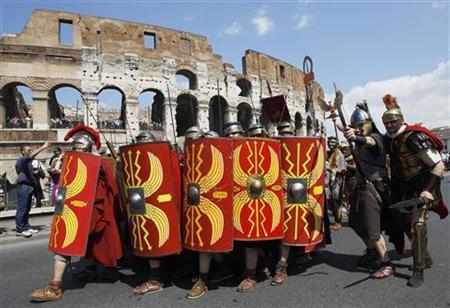发表在新一期《自然》杂志上的一篇研究报告指出,罗马帝国和中国汉朝鼎盛时期的200多年间,温室气体排放曾大量增长。该研究对联合国之前的研究观点提出质疑,联合国的观点认为,人为造成的气候变化是从1800年左右才开始的。格陵兰岛冰块储存的气体记录资料表明,大气中的甲烷含量在大约2000年前上升,并在较高水平上保持了约两个世纪。
该研究的主要执笔人表示,甲烷可能是在毁林造地和用木炭作燃料锻造金属武器等过程中释放的,按人均来讲,当时的温室气体排放量已经相当高了。不过这位主笔也指出,跟如今70亿人口的排放量相比,2000年前全球仅有的3亿人口造成的排放量自然就不显得那么高了。科学家们在报告中称,毁林现象在公元 200年出现减少,这跟汉朝灭亡和罗马帝国衰退后中国和欧洲的人口锐减有关。研究人员预计,过去2000年间甲烷排放总量中,1800年前的排放量占 10%,而工业革命以来的排放量占90%。人为因素产生甲烷的行为包括焚烧森林和矿物燃料、稻田、牲畜和废渣填埋场,而湿地、野火和泥火山等自然因素也会释放甲烷。

Members of the Gruppo Storico Romano (Roman Historical Group) dressed as centurions perform as they march past the ancient Colosseum in Rome, to mark the 2,764th anniversary of the founding of the city April 17, 2011.(Reuters)
A 200-year period covering the heyday of both the Roman Empire and China's Han dynasty saw a big rise in greenhouse gases, according to a study that challenges the U.N. view that man-made climate change only began around 1800.
A record of the atmosphere trapped in Greenland's ice found the level of heat-trapping methane rose about 2,000 years ago and stayed at that higher level for about two centuries.
Methane was probably released during deforestation to clear land for farming and from the use of charcoal as fuel, for instance to smelt metal to make weapons, lead author Celia Sapart of Utrecht University in the Netherlands told Reuters.
"Per capita they were already emitting quite a lot in the Roman Empire and Han Dynasty," she said of the findings by an international team of scientists in Thursday's edition of the journal Nature.
Rates of deforestation "show a decrease around AD 200, which is related to drastic population declines in China and Europe following the fall of the Han Dynasty and the decline of the Roman Empire," the scientists wrote.
Mankind's emissions 2,000 years ago, when the world population was an estimated 300 million, were discernible but tiny compared with current levels caused by a population of 7 billion.
Sapart estimated that methane emissions until 1800 were about 10 percent of the total for the past 2,000 years, with 90 percent since the Industrial Revolution.
Methane is generated from human sources including burning of forests and fossil fuels, rice paddies, livestock or landfills. Natural sources include wetlands, wildfires or mud volcanoes.
The findings by Sapart's team questioned the view by a U.N. panel of climate scientists that man-made climate change started with the surge in use of fossil fuels during the Industrial Revolution.
"The pre-industrial time was not a natural time for the climate - it was already influenced by human activity," she said. "When we do future climate predictions we have to think about what is natural and what did we add. We have to define what is really natural," she said.
The scientists, in the Netherlands, Switzerland, Denmark, the United States and France, noted a second rise in methane in Medieval times, coinciding with a warm period from 800 to 1200 that also saw Europe's economy emerge from the Dark Ages.
That spike might be because population growth in Asia and Europe led to more deforestation for farming.
Rates then fell, perhaps partly because factors such as the Black Death cut the population.
Methane levels rose a third time around the start of a cool period known as the Little Ice Age in the 1500s, perhaps also reflecting strong population growth after the plague.
The scientists used variations in the chemical make-up of methane in the ice to try to distinguish background natural sources from man-made emissions.
Ice cores from Greenland - made up of layers of compacted snow that give a year-by-year record - found concentrations of methane rose from about 600 parts per billion around 2,000 years ago to above 700 ppb by 1800.
They are now at about 1,800 ppb. Methane is the second most important greenhouse gas behind carbon dioxide, emitted by human burning of fossil fuels.
A U.N. panel of climate scientists has said the build-up of greenhouse gases is pushing up temperatures and causing more droughts, floods, and rising sea levels.
编辑推荐:
